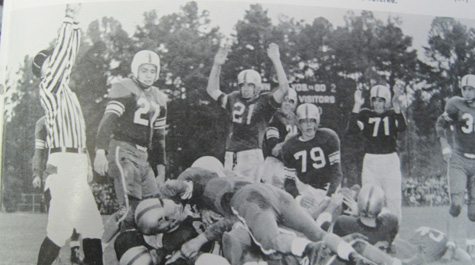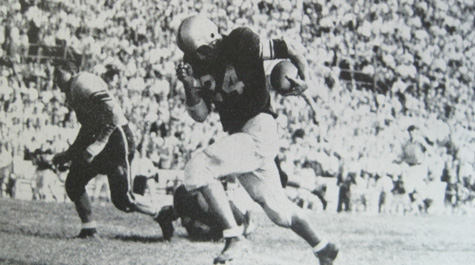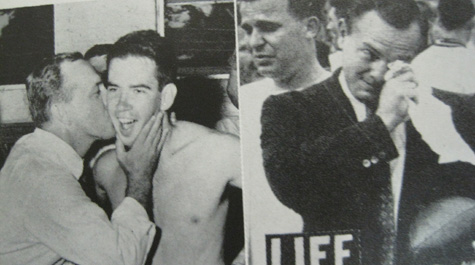"Iron Indians" recalls a season of grit, determination
Rene A. Henry didn’t fabricate any of the details of William & Mary’s 1953 football season for his new book, “The Iron Indians.” He didn't have to. The truth, as they say, is so much stranger than fiction.
Henry ’54, a 2011 Alumni Medallion recipient, gives an unvarnished account of the circumstances that set up one of the most amazing stories in Tribe athletic history.
The College, then sporting about 1,500 students, had barely finished ringing in the New Year 1953 when the hinges came off the school – literally and figuratively.
Some students removed a door in Blow Gymnasium that led to the Military Science Department and stole an ROTC final exam. They then shared it with others in the class, many of them athletes – a blatant violation of the Honor Code, sacred at the College since 1779.
Thirty-six students were brought up before the Honor Council. There was no bluffing one’s way through this: The Army colonel who prepared the test deliberately made one question so difficult that he didn’t expect anyone to answer it correctly. Instead, just the opposite happened.
When all was said and done, eight starting football players – including the two co-captains – were dismissed. Nearly half of the remaining 33 players transferred. Scrambling to find bodies, the “Indians,” as they were called then, began the season with 24 football players. Five were veterans returning from the Korean War or service in the South Pacific. One kid, John Risjord, had never played a down of football in his life.
The kicker stood 5-feet-8 and weighed 125 pounds; not too bad considering one of the two quarterbacks, Al Grieco, was 5-8, 160. Another player, Bill Marfizo, played seven different positions in one game.
Coach Jack Freeman ’46 had so few bodies that when the offense practiced a play that was supposed to be run to the right, the left side of the offensive line played defense, and vice versa. The staff was spartan, too. Freeman had just five assistants, including the W&M basketball coach and a graduate student. One of the two athletic trainers was a Williamsburg fireman.
Not by today’s standards, perhaps, but the schedule was daunting: Wake Forest, Navy (ranked No. 1 in the East), Cincinnati, Virginia Tech, George Washington, N.C. State, VMI, Richmond, Washington & Lee, and Boston University. Aware of what was happening in Williamsburg, opponents began calling the athletic department to make sure William & Mary planned on showing up for its games.
They needn’t have worried. Under Freeman, the “Iron Indians” posted a record of 5-4-1. On the surface, that doesn’t seem noteworthy, but for two factors: W&M wouldn’t enjoy another winning season for 12 years, and the Tribe started out 5-2-1 until decimated by the almost inevitable rash of injuries.
Henry, who was a student working as the College’s sports information director at the time, wrote the book, in part, out of frustration at the state today of “big-time” college football.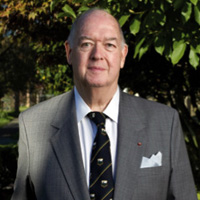
“Over the past several years I've written a number of articles about how college football costs are getting out of control and no one is doing anything about it,” he said. “It also is impacting the overall costs of higher education, since many of the athletic fees are passed on to the students, and for capital improvements to stadiums and arenas, to taxpayers. I cited the '53 Iron Indians as an example of why no college needs 125 players on a team or 85 scholarships.
(It should be noted that William & Mary competes in football at the I-AA, or FCS, level. The College is limited to 63 scholarships, and has a significantly smaller budget than the I-A, or BCS, competitors Henry refers to.)
“Several friends suggested I develop this into a feature motion picture. I started the project and found as I was developing a screenplay, I had a book. Then I decided to go with the book first and readapt it with a great deal of material and anecdotes that will allow me to bring it alive on the screen.” Henry is seeking financing for that project.
The Iron Indians opened the season with a 16-14 victory over Wake Forest in the Tobacco Bowl in Richmond. Quarterback Charlie Sumner, later a two-time, Super Bowl-winning defensive coordinator with the Oakland Raiders, ran 33 yards for one touchdown, while “Bullet” Bill Bowman raced 71 yards for another.
The following week, the College took on Navy in Annapolis. Tiny Al Grieco replaced a struggling Sumner at quarterback and passed 23 yards to co-captain Tommy Martin for the touchdown that knotted the score at 6-6. That’s how it ended, an amazing outcome for a W&M team that was at least a two-touchdown underdog. A photographer for LIFE magazine caught a shot of Freeman wiping away tears after the team presented him with the game ball, and it made the cover.
After a lopsided loss to Cincinnati, W&M came back to topple Virginia tech, 13-7, George Washington, 12-7, and N.C. State, 7-6.
A one-point loss to VMI on a last-second touchdown was a noticeable blemish, but W&M came back the following week to shut out Richmond, 21-0 in front of a Homecoming crowd of 18,000.
By then the injuries had mounted, and the Iron Indians finished the season with losses to Washington & Lee and Boston University, the latter when only 14 players weren’t suffering from some sort of injury.
When the season was done, the team was honored at a special convocation at the old Phi Beta Kappa Hall. Most of the student body turned out for what would be the last public event ever held in the old hall. Two weeks later, with students away on holiday break, it burned to the ground.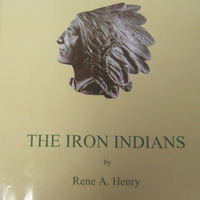
Henry makes the point that the Iron Indians were more than just special college football players. Most entered the armed forces after college. Three became prominent lawyers. Six were drafted or played professional football.
“The morality and character of the players is what one would hope all student-athletes today would be,” he said. “Many are at W&M, but not the major schools. This team is an example of what we need in college football (and all sports) today and I challenge all college and university presidents and chancellors to take control and bring reality back to the game. Sports exist because of the institution, not the other way around.
“The players graduated. They were all successful. They all had part-time jobs. There were no weight rooms, fitness trainers, nutritionists or other specialists. Compare that with many of the players in BCS football today.”
Several years ago, Henry established an endowment in the Office of Sports Information. “I owe so much to William & Mary. My liberal arts education prepared me to succeed in my professional career in many diverse areas – public relations, sports, the TV-film-entertainment industry, association management, housing and real estate, higher education, marketing.
“I worked in sports information as an assistant when I came to William & Mary, and when Jack Freeman gave me a $10 a month raise to be the sports information director in January '53, it jump started my career.”
 Skip to main content
Skip to main content

